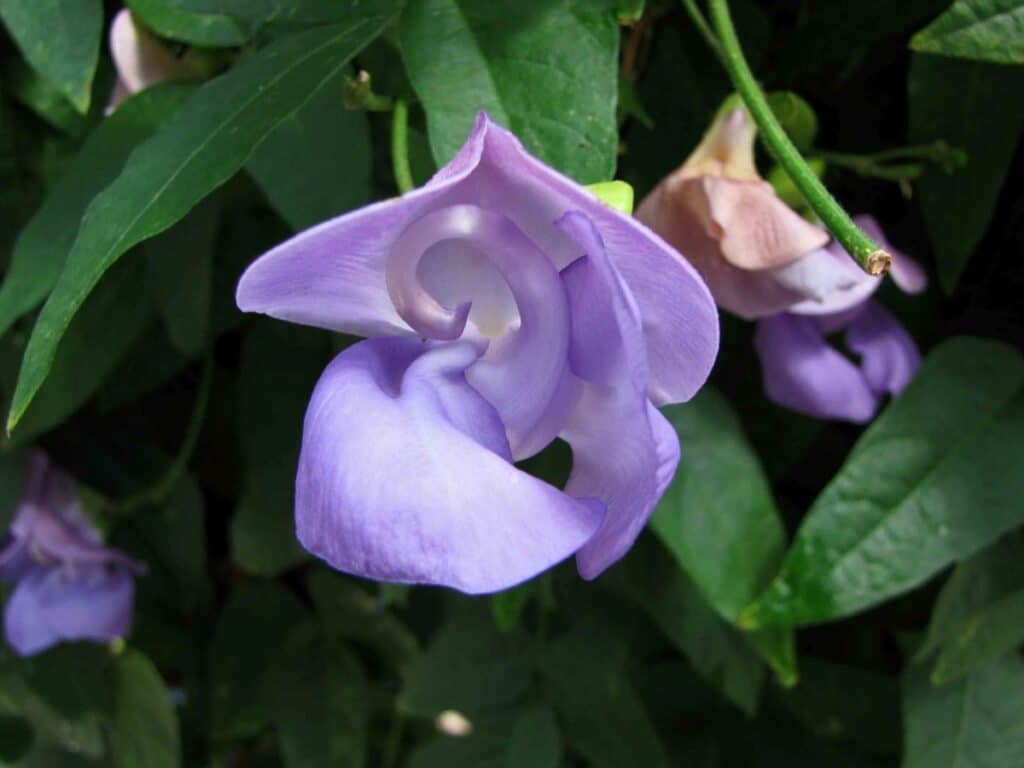Plants that offer a certain uniqueness to the landscape bring an additional aesthetic. The snail vine is one of those plants, with its flowers looking like a snail shell or corkscrew. That is not something most landscapes have.
Read on to know more about this magnificent plant and how to incorporate it into a garden.
Botanical Information
The Vigna caracalla, formerly known as Phaseolus caracalla or Phaseolus giganteus, is the scientific name for the snail vine, but also has common names corkscrew flower, corkscrew vine, snail bean, Chinese wisteria, or corkscrew vine.
The name comes from the Portuguese “caracol,” meaning “snail vine plant.”
Thomas Jefferson called the snail vine plant, “the most beautiful bean plant in the world.”
Once you see its pale purple or white flowers (both flower color options are available), you’ll likely agree! With multicolored spirals that thrive in direct sun and well drained soil, the corkscrew vine has fragrant flowers with white flowers – snail shaped flowers.
The snail vine is a member of the Fabaceae family, which also goes by the name pea family because of the fruits the species under this family produce. It’s part of the genus Cochliasanthus caracalla, hence
Moreover, Vigna is a genus that caters to most of the economically utilized crops in different parts of the world, such as mungbean, rice bean, and urn bean. Along with this benefit, they also produce beautiful and unique flowers, making them a suitable addition to a garden full of edible plants.
Spatial Distribution
The snail vine flourishes in areas under USDA Zones 9 through 12. It survives in such places because it is a native of tropical South America and it is used to being in a warm climate.
However, the corkscrew vine may be planted in colder climates with the help of structures, such as greenhouses, to mimic the suitable growing environment for them.
If you live in a place with extreme winter temperatures where cold weather is the norm, you can still grow this hard to find corkscrew vine. However, if you experience frost, you may want to bring it indoors.
A single summer often is not enough for the immature blossoms to fully show their true potential, but bringing the snail vine inside during cold weather can help it thrive so you can enjoy it in future seasons.
Growth Habits
After knowing where the corkscrew vine came from, knowing its growth habits is essential to ensuring its good health. It is a perennial plant but may also be grown as an annual crop depending on the climate. As a fast-growing evergreen vine, the snail vine plant spreads vastly for 10 to 20 feet.
Thanks to its ability to cover a chunk of an area in a short time, the corkscrew vine serves multiple functions in a garden. In some cases, its bushy appearance is preferred to be more refined and cleaner. In this case, providing structural support for the vine to cling on to is the best thing to do.
Knowing these habits will help one decide what function this snail vine will execute in a landscape. Moreover, the appearance of the whole plant will play a huge role in determining the purpose. Below are the main plant parts and their characteristics.
Leaves
The snail vine has its foliage arranged alternately on its slender stems. Also, its green leaves are trifoliate, with three leaflets. Each leaflet is either ovate or lanceolate that extends up to 3 inches long.
Flowers
The flowers of the snail vine are the main attractions. From July to October, they will surely steal the show with its attention-grabbing appearance. Commonly, they are light violet to white with a unique form.
Each flower on the snail vine has a twisted petal that resembles a snail’s shell or corkscrew, which is where it got its common name. Along with this note-worthy characteristic, the flowers have a strong scent.
Fruit and Seeds
Ants are the key pollinators for the snail vine. They help them produce fruits after flowering, wherein 5 to 7-inch long bean pods immediately follow. Inside the pods are brown seeds.

Grow and Care Tips
Here are a few tips to help you produce the most gorgeous flower color, whether they’re pale purple or white buds, on your highly fragrant and fast growing snail vine plant.
Sun Requirement
The snail vine loves to be in full sun but thrives under partial shade too. However, if robust flowering is preferred, put the plant under 6 hours of continuous sun exposure.
Full sun will encourage the most rapid growth of this vining plant, as will high heat and high humidity. Remember, this plant is native to Central and South America, so provide it with conditions that will mimic the growing season and climate in these places.
Water Requirement
For the plant to prosper, frequent watering in moderate amounts is imperative. The watering program should be altered depending on the weather, wherein an increase in temperature means an increase in watering and vice versa.
So if you have your plant in full sun, provide high humidity and regular watering. If you can, use warm water.
This will help make sure your snail vine plant doesn’t dry out. Again – you’re going for the climate you’ll find this plant has in its native region of Central and South America.
Temperature and Humidity
As a tropical plant, the snail vine plant can tolerate warm environments, but the lowest temperature it can handle is around 40 degrees Fahrenheit.
Soil Requirement
The snail vine grows well when planted in soil with good drainage and rich in organic matter. Aside from these characteristics, it is also critical to provide enough room for the plant to grow. Allot 8 to 12 inches for planting distance from other plants and structures.
The snail vine prefers slightly acidic soil (well drained soil is again ideal).
Fertilizer Requirement
Slow-release granular fertilizer is applied every 2 to 4 months, depending on the plant’s response. Avoid putting nitrogen-rich fertilizers when flowering because it will increase the foliage production rather than the blooms.
Maintenance Activities
Aside from watering, pruning is also an activity to schedule. Depending on the age of the plant, pruning is adjusted accordingly. Removal of dead and damaged plant parts is done whenever necessary, along with trimming parts that exceed their boundaries and disrupt surrounding fixtures and vegetation.
Propagation
There are two main ways to reproduce snail vines, with the use of seeds, and stem cuttings. They are relatively easy to germinate and grow by seed, but using softwood cuttings will take less time for a new plant to grow.
For both planting materials, having well-drained and moist soil under warm and humid conditions is beneficial. Moreover, the use of plant growth regulators, such as auxins or rooting hormones, will hasten the development of a vast root system.
Function In The Landscape
As a beautiful addition to the landscape, the snail vine is incorporated into trellises, hedges, fences, and privacy screens. Its vast growth helps it cover more area in a short period, which results in a dense screen or shade.
Also, it makes a good climbing plant for vertical landscaping and green walls. Some plant them in pots with some support, such as stakes. Moreover, liriope, viburnum, and hydrangea plants are good companions for the snail vine in a garden.
As mentioned above, the vine is grown indoors when it is too cold. Furthermore, it can be an indoor plant regardless of the climatic conditions outside as long as it is placed near a window or a grow lamp is provided.
Aside from being a beautiful ornamental plant, the vine also serves as a nitrogen-fixing plant. This attribute means that this vine has a symbiotic relationship with a rhizobacterium, which helps convert the nitrogen in the air into a form plants can use.
Potential Harm
Regardless of how beautiful the snail vine may be, there are still potential dangers it may cause if left unruled. Since it is an aggressively growing vine, not pruning and training would let the vine crawl everywhere.
This habit might cause ecological disruption in a landscape by killing other plants. This potential harm is the reason why ecological responsibility comes along with the aesthetics the snail vine offers.
Grow This Wonderful Vining Plant Today!
So what do you think? is the snail vine a plant you want to add to your garden list?
Without a doubt, this is one of the most intriguing plants you’ll find. With its tear drop shaped petals and uniquely shaped flowers that resemble small snails, this plant in the bean family is typically grown by advanced gardeners, but that doesn’t mean you can’t give it a try!
It’s said to be the most beautiful bean in the world. Go see for yourself!
FAQs
See more vine plants you can grow.
References
Reference List:
https://www.sciencedirect.com/topics/agricultural-and-biological-sciences/vigna
http://www.public.asu.edu/~camartin/plants/Plant%20html%20files/vignacaracalla.html
https://www.itis.gov/servlet/SingleRpt/SingleRpt?search_topic=TSN&search_value=505693#null
https://aces.nmsu.edu/pubs/_a/A129/
Close






